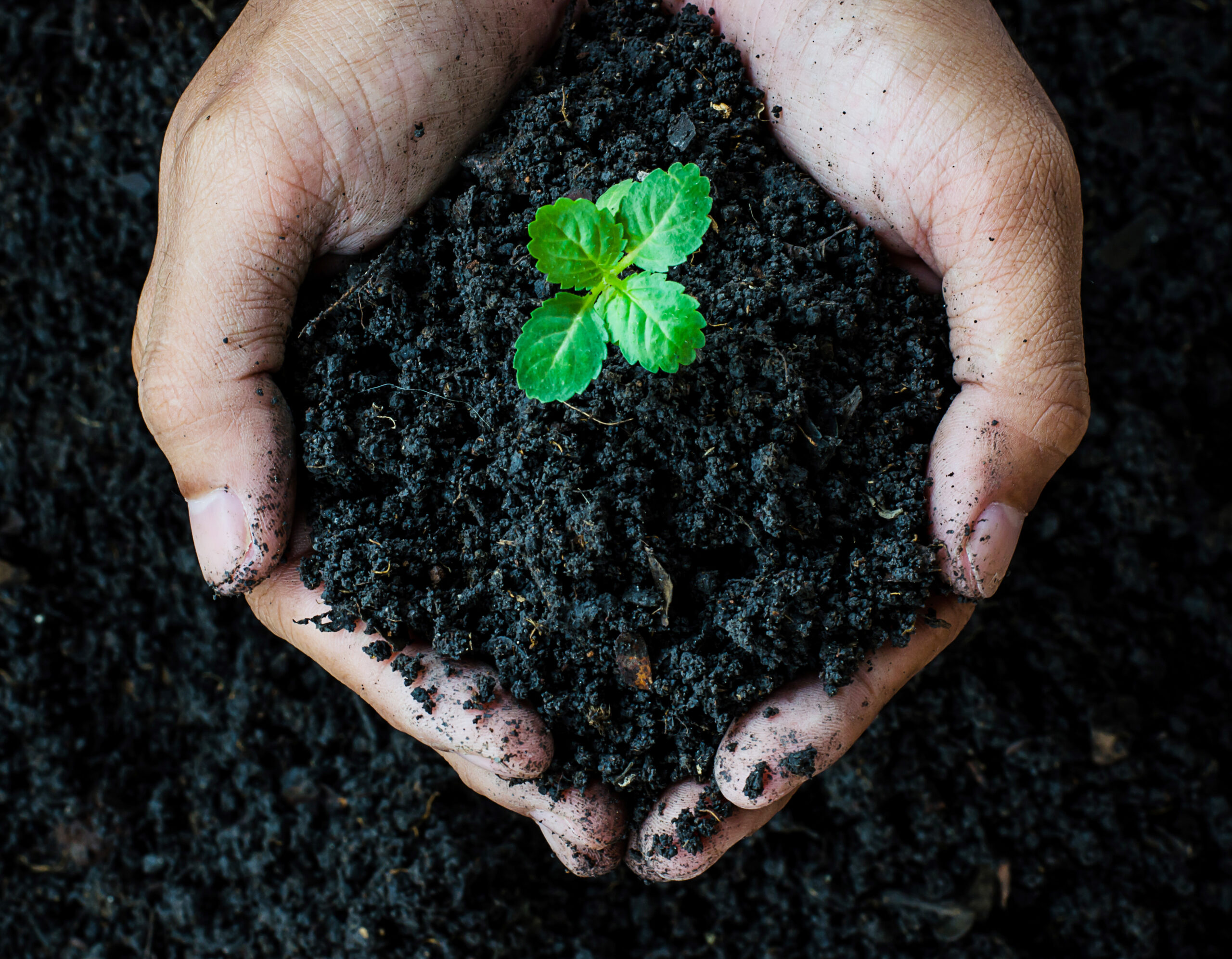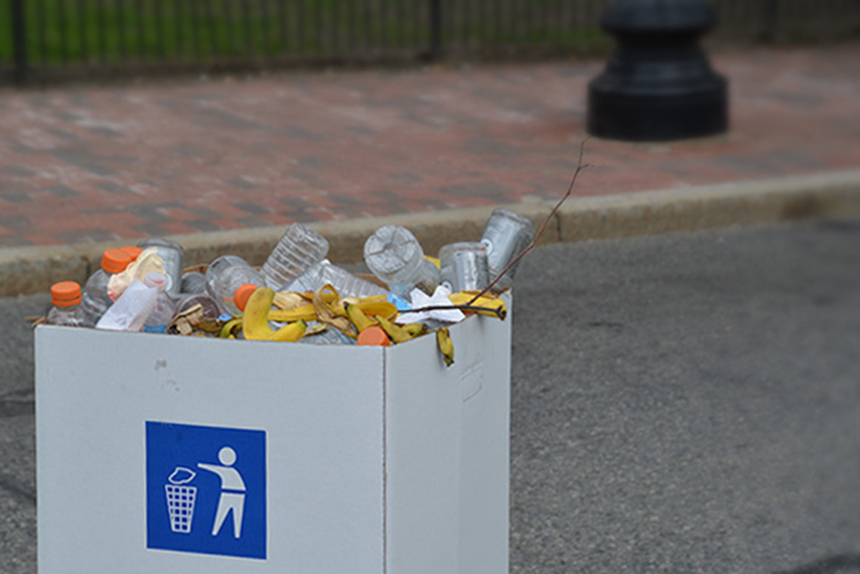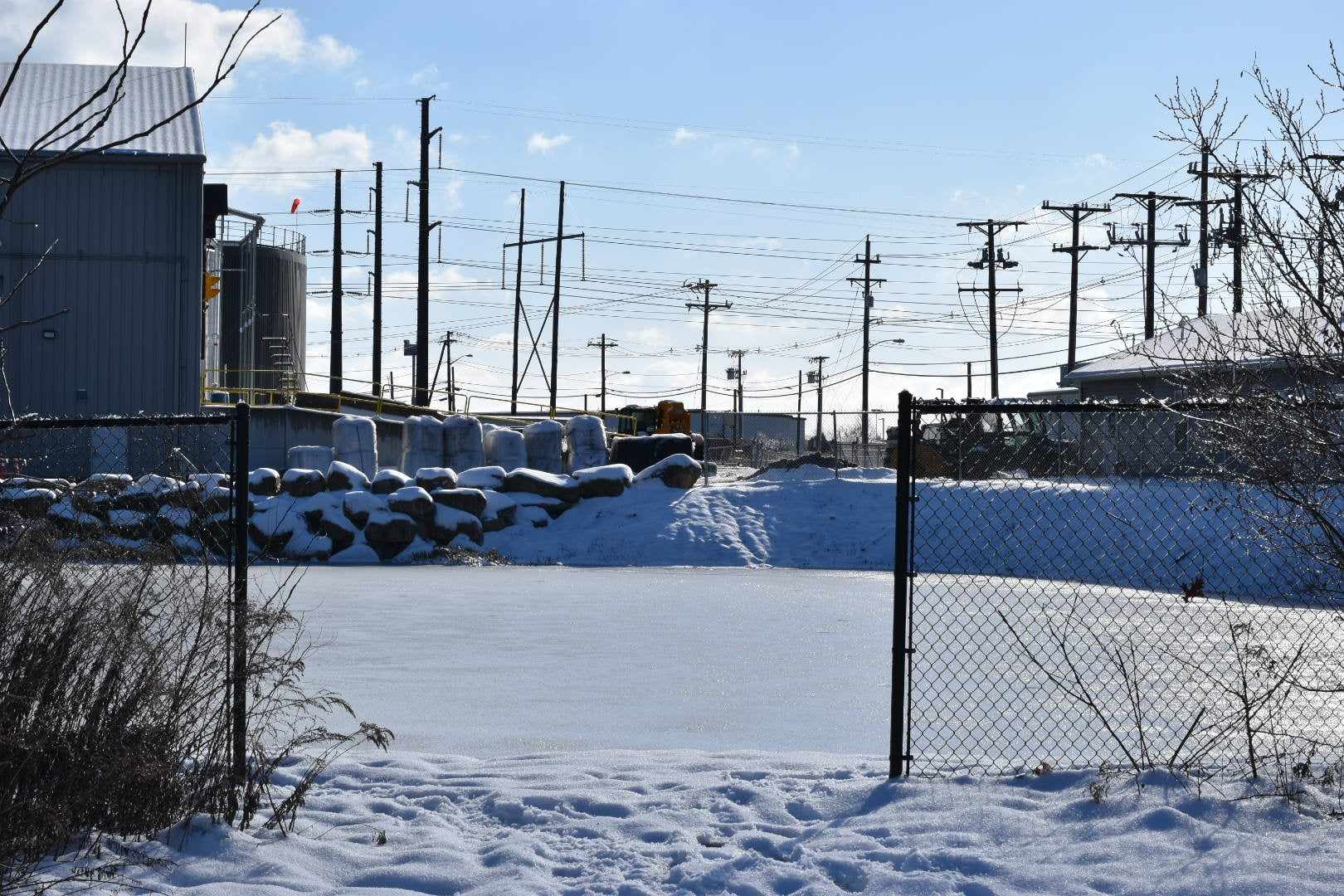Change to Single-Stream Recycling Hasn’t Paid Off
As the amount of plastic being produced increases, Rhode Island’s recycling rates don’t keep pace and they aren’t meeting expectations
December 13, 2019
Recycling is in a rut in Rhode Island, and time is running short to fix the problem.
Since single-stream recycling was implemented in 2012, the state’s recycling rates have improved modestly. The average annual municipal recycling rate of 21.5 percent is 16 percent higher than the year before the Rhode Island Resource Recovery Corporation (RIRRC) made the $16.9 million upgrade to it materials recycling facility (MRF). But that increase has reached a ceiling, and the quasi-state agency that manages the Central Landfill in Johnston and runs the state’s only MRF expects Rhode Island’s recycling rates to be significantly higher.
“I don’t think the switch to single stream has shown a big increase in the overall recycling rate at the MRF,” said Jared Rhodes, RIRRC’s director of policy and programs.
With its optical scanners, magnets, and electric pulses, the high-tech sorting machine succeeds at separating recycling materials from the waste stream and bailing it into multi-ton cubes that are ready for shipping to processors worldwide.
The problem with recycling is the human element that exists outside the walls of the MRF.
From the outset, the drawbacks of single-stream recycling were known. Despite the convenience and cost-savings of a single collection bin and automated pickup, mixing paper, plastic, and glass increases contamination to as much as 15 percent, turning perfectly good recyclable items into trash.
Broken glass, stretchable plastics, such as bags, and liquids degrade many loads of recyclables before they reach the MRF. In particular, paper mixed with broken glass is damaging to pulp mills. Rain and snow will send a truckload of recycling to the landfill. Some so-called “approved items” for the bin such as irregular plastic containers and frozen-food boxes also reduce the quality of recyclables that are eventually sold as raw material for new products.
The problem of trashed recycling isn’t a local issue, as communities across North America are recognizing the drawbacks of single-stream recycling and adapting. Cities and towns in Florida, New Jersey, and New York are moving away from the one-bin system to dual-stream collection. In September, California signed a law that urged municipalities and other entities to revert to dual stream.
Victor Bell, president of the Jamestown-based packaging consulting firm Environmental Packaging International (EPI), said the contamination problem should impel Rhode Island and other states to follow the example of communities in United States and Europe that segregate recycling into multiple bins at the curb and at public drop-off receptacles.
Bell, while working at the Rhode Island Department of Environmental Management (DEM), wrote the state recycling laws enacted in 1986. He noted that a litter tax imposed on beverage containers at the time paid for enforcement and inspections to ensure businesses and multifamily housing units were complying with the rules. The General Assembly, however, has since shifted the roughly $2 million litter-tax revenue to the state’s general fund.
“No one has enforced that law since I left 26 years ago,” Bell said.
The recent return to dual-stream recycling was largely prompted by China’s National Swords policy that began in early 2018. Halting the import of many recyclables, much of it contaminated with garbage and useless plastics and paper-based products, prompted neighboring countries such as Thailand, Malaysia, and Vietnam to tighten their rules on recycling imports. The loss of dumping grounds for mixed paper and poor-quality plastics flooded domestic markets with unwanted material and few places to take them. Prices for all materials crashed. Crippling the mostly for-profit waste management industry.
Many communities stopped taking certain items at the curb, and others shipped recyclables directly to incinerators or, in a few cases, suspended recycling collection altogether. This put pressure on the recycling industry to clean up the quality of what it collects and ships to its vendors and to re-evaluate the widely used single-stream system.
Rhode Island, for one, is examining its waste-management practices. The state-owned MRF hasn’t made a profit since 2015, but is weathering the drop in recycling sales with revenue it receives from tipping fees it collects at the Central Landfill.
Communities where waste management is privatized, however, aren’t as fortunate, and most MRFs are taking fewer recyclables, paying paper mills and other processors to take their materials, or closing because of the crash in commodity prices.
Rhode Island like other states also faces the problem of running out of space to bury its trash and contaminated recycling, which at the moment uses all of its glass as a debris cover for the landfill. The Central Landfill is expected to reach capacity by 2034.
Massachusetts is projected to lose 85 percent of its landfill capacity within six years. Connecticut’s last landfill expects to close in 2024. Both state’s have trash incinerators, also called waste-to-energy facilities, but they are aging and prone to breakdowns. Connecticut and Massachusetts expect to increase waste shipments to landfills in Ohio and Pennsylvania and plan to enact mandates to sharply shrink the size of their waste streams. Massachusetts aims to cut its waste 30 percent by 2030 and 90 percent by 2050.
Recycling in general faces other problems: low recycling rates and a glut of new plastics. In all, less that 5 percent of plastics get recycled and only about 8 percent of the material that makes it to recycling centers gets turned into new products, according to the Environmental Protection Agency.
“Recycling is not really the solution,” said Terrence Gray, DEM’s deputy director of environmental protection. Gray noted that 50 percent of all plastics are used only once.
“It’s a disposable society and it’s going to be a real challenge to reverse that trend,” he said.
Efforts to fundamentally change recycling will be a challenge. Bell pointed to producer responsibility efforts such as the New Plastics Economy Global Commitment led by Ellen MacArthur Foundation. With the backing of multinational consumer goods companies, the project aims to eliminate plastic that can’t be recycled, embraces reusable packaging, and wants to reach the goal of reusing, recycling, or composting 100 percent of plastic packaging by 2025. But it has a growing wave of plastics to address.
Thanks to a glut of domestic natural gas and oil caused by the fracking boom, the fossil-fuel and plastics industries are investing $65 billion on more than 300 projects to expand domestic plastics production. And rather than reduce plastics, bottlers and the recycling industry want more of the “good,” profitable plastic like PET and HTPE — Nos. 1 and 2 — moving through the system to boost their profits.
At an October meeting of the Northeast Recycling Council in Providence, recycling industry groups, backed by petrochemical companies and bottlers, said the solution isn’t to shrink the recycling stream but expand and streamline the current collection system, albeit one that is largely funded through taxes and relies on buy-in from consumers and businesses.
Dylan de Thomas, vice president of industry collaboration for The Recycling Partnership, said the primary problem is “people putting items in the system that aren’t recyclable.”
In much of the country, he said, it’s cheaper to throw recyclables in a landfill than to recycle. He noted that increasing the amount of plastic that the recycling industry wants and will pay for will make everything profitable.
To get there, he said, “make sure everyone is participating and doing it the right way.”
Single-stream recycling, de Thomas added, has flaws but it “is not the enemy. But single stream without education can be really challenging for the system.”
Of course, funding such operations relies on investments in education and recycling campaigns to collect singe-use materials that processors can then sell. In Rhode Island, and elsewhere, those revenue streams are shrinking.
There is also the issue of climate change. Rhode Island has nearly the same deadline to fix its waste and recycling problem as the rest of the world does to radically curtail greenhouse-gas emissions. The manufacturing, disposal, and transportation of plastic bottles and packaging is a major source of emissions, putting further pressure on the reuse elements of the circular economy advocated by the Ellen MacArthur Foundation and others.
Some environmentalists see the macro approach as endorsing business as usual for the plastics industry, beverage companies, and other users of single-use packaging. The adoption of reuse programs has yet to take hold except by mindful consumers.
But if Rhode Island, with more than 30 years of recycling, is any indicator, the problem of managing waste is largely unsolved. Everyday items, like disposable coffee cups and takeout containers, can’t be recycled and often contain harmful chemicals such as per- and polyfluoroalkyl substances (PFASs) that are detrimental to composting and recycling.
Consumers are confused by the complex and ever-changing rules about what can and can’t go in their recycling bins. With no enforcement, business and apartment buildings have no incentives to pay for private collection.
“As worthwhile as recycling efforts are, and as much as we need to support them with our local ordinances and individual actions, we simply can’t expect recycling to get us out of this mess,” according to the National Resources Defense Council.
But a more fundamental shift is underway and working its way across the country. Hundreds of bans on plastic shopping bags and other single-use plastics are in place in multiple states and many municipalities have set zero-waste goals.
In Rhode Island, 16 communities have approved bag bans. In 2012, Barrington led the way with the first bag ban in the state and recently enacted bans on other single-use food-service items such as plastic straws and Styrofoam containers.
Rhode Island, as a state, is behind in adopting similar bans. The governor’s 22-member Task Force to Tackle Plastics included environmental organizations, business groups, municipal officials, and experts in the waste-management arena. The committee presented many ambitious waste-reduction solutions, such as a bottle bill and expanded producer responsibility programs, that weren’t adopted. The group also failed to enact what 16 municipalities have done: ban plastic shopping bags.
Gov. Gina Raimondo has promised to continue the mission of the task force, which was created in 2018. She didn’t respond to a request for comment on how and when that will happen.
Four New England states have reduced waste from aluminum cans and plastic and glass bottles by enacting bottle bills, a program that mandates a returnable deposit on most beverage containers. A 2009 study by RIRRC found that a 5-cent deposit in Rhode Island would double the recovery rate of bottles and cans to about 80 percent. But only the General Assembly can pass a bottle bill. Legislation is introduced nearly every year, but it’s quietly defeated by the beverage and bottling industry, retailers, and restaurants that fear cost increases.
Most bottle-redemption programs are managed by the bottling industry. Under the study’s proposed law, RIRRC would manage the program. Their costs would increase but there would be less contamination of recycled material. Municipal collection costs would decease. Other benefits include reduced greenhouse-gas emissions, less waste in the landfill, and less litter.
RIRRC hasn’t advocated for a bottle bill, but the quasi-state agency is crunching the costs and benefits of expanding curbside collection and municipal transfer-station operations that could in a sense create a multi-stream recycling system. Food scraps, which account for about 30 percent of all landfill waste, are also being considered for collection.
“We’re looking at the collection costs, because that’s what’s important to municipalities and because they are paying for the service,” Rhodes said.




When I lived in Las Vegas in the 90s we not only had separate bins for paper, plastic and metal, we had 3 separate bins for glass: clear, green, and brown. I was told that just one brown or green bottle would spoil a whole batch of clear glass, but other colors could be put in with the brown.
I served on the state litter task force before the DEM finally stopped even pretending to support it. The Beverage industry did everything it could to prevent recycling. MAny of us knew years ago that switching to single stream recycling was idiotic, but it was an effort to mechanize everything and reduce employment,. It has turned out to be as idiotic as we thought it would be. I think it is time to put legislative leadership in the dumpster until they figure out that we should not allow anything that can not be recycled effectively to be sold in the state.
I know this was mainly about plastics, but adding to the problem is Food in trash causes contamination and increases methane in the atmosphere. But in California, they turn food trash into gold with a green bin for compost! With compostable bags, it makes it even easier to put food scraps into a green bin without attracting critters. They also use compostable take out containers, and you can compost most cardboard. That is one way to truly “ Re- Cycle” and make usable soil in the process . Its too bad some engineering school can not figure out how to incinerate trash to make energy/ electricity but filter out the smoke so it does not pollute. I hear URI just got some millions in grant money from the original Hasbro CEO…HOW BOUT IT???
Thanks for this detailed article. We have been trying to work around or accommodate the percentage of people who are lazy, messy, unobservant, etc., since the beginning of the municipal program. Our culture tries to make everything easy for the consumer– prepared foods, mixed recyclables disposal, multi-packaged food that remain fresh or warm or whatever condition appeals the customer. We receive benefit from this system. Our cultural conflict between I/Thou, individual/group makes finding a satisfactory center not only difficult, but like any median doesn’t deal with the tails of the curve, especially the side of the curve that brings negative consequences.
Without "convenience" we are forced to bring our own bags for shopping, compost our own food scraps, bring our own thermal cups to the drive-through window/ take-out counter, make a choice about what kind of container our "stuff" comes in. Those to whom the burden is shifted will complain.
What is the most effective system to capture the most beneficial return to prolong landfill space and what is the greatest health-protective disposal of waste? We know the answers. We don’t agree on who should bear the burden or how to see all of this as a cost of living about which we should make rational choices.
I would like to offer hope, but from my experience I see only that we will continue to muddle.
Maybe we need to completely rethink this-
https://www.pri.org/stories/2012-06-26/sweden-imports-waste-european-neighbors-fuel-waste-energy-program